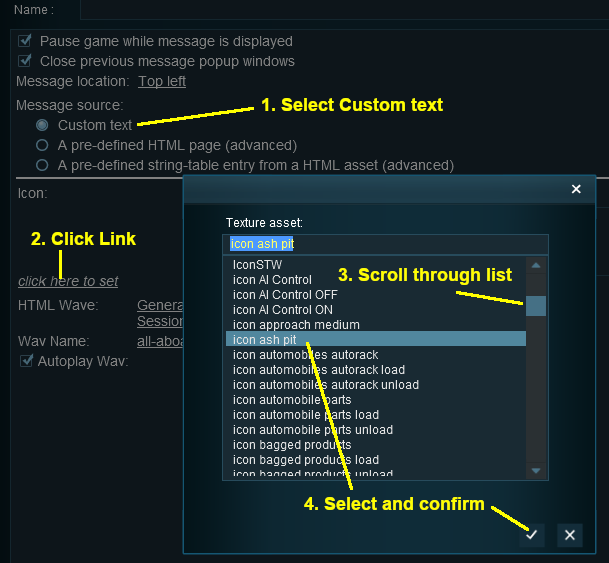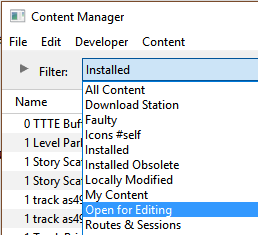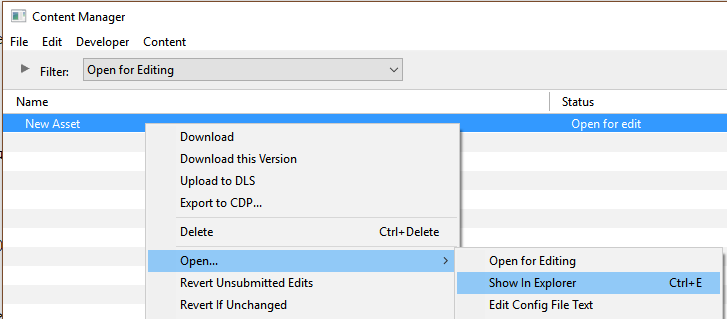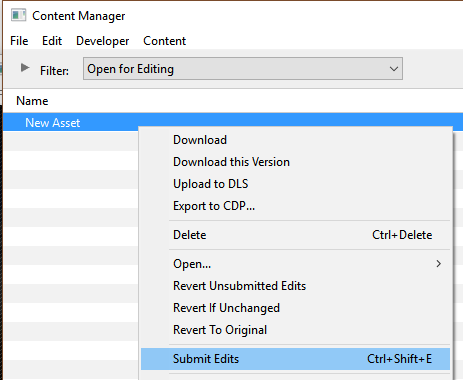How to Create a Message Popup Icon
(→The Config.txt File) |
m (→The Config.txt File) |
||
| Line 223: | Line 223: | ||
='''The Config.txt File'''= | ='''The Config.txt File'''= | ||
| − | This file should follow the same (or a similar) format as the example below. Entries in <span style="background-color: blue; color: white; font-weight: 700;"> blue </span> will be different for each asset. The order of the "tags" is not important:- | + | This file should follow the same (or a similar) format as the example below. Entries in <span style="background-color: blue; color: white; font-weight: 700;"> blue </span> will be different for each asset. The order of the "tags" is not important:- |
'''kuid''' <kuid:<span style="background-color: blue; color: white; font-weight: 700;"> this is an auto-generated number </span>> | '''kuid''' <kuid:<span style="background-color: blue; color: white; font-weight: 700;"> this is an auto-generated number </span>> | ||
| Line 258: | Line 258: | ||
<td><span style="font-size: 17px;">'''Settings:'''</span><br> | <td><span style="font-size: 17px;">'''Settings:'''</span><br> | ||
'''For the above example:'''<br> | '''For the above example:'''<br> | ||
| − | *The <span style="background-color: blue; color: white; font-weight: 700;"> kuid </span> is unique to every asset so it is | + | *The <span style="background-color: blue; color: white; font-weight: 700;"> kuid </span> is unique to every asset so it is <span style="background-color: red; color: white; font-weight: 700;"> not a good idea to choose your own </span> . This will be automatically generated by the '''Content Manager''' program when a new asset is created |
*The <span style="background-color: blue; color: white; font-weight: 700;"> kind </span> identifies the ''type'' of asset and the types of files that '''Trainz''' will expect to find in the asset. It also tells '''Trainz''' how to render and error check the asset. A list of asset kinds can be found at [[file:WikiLink.PNG|link=]] '''[[KIND_TrainzBaseSpec#KIND_Hierarchy|KIND Hierarchy]]''' | *The <span style="background-color: blue; color: white; font-weight: 700;"> kind </span> identifies the ''type'' of asset and the types of files that '''Trainz''' will expect to find in the asset. It also tells '''Trainz''' how to render and error check the asset. A list of asset kinds can be found at [[file:WikiLink.PNG|link=]] '''[[KIND_TrainzBaseSpec#KIND_Hierarchy|KIND Hierarchy]]''' | ||
*The <span style="background-color: blue; color: white; font-weight: 700;"> texture </span> is the name of the assets '''texture''' file. This will be a simple text file and will have the name '''<span style="color: blue;">asset_name</span>.texture''' where '''<span style="color: blue;">asset_name</span>''' will be a name you have selected for this asset - e.g. "ashpit.texture". The actual texture file itself will be named '''<span style="color: blue;">asset_name</span>.texture.txt''' (e.g. "ashpit.texture.txt") but the filename ending "'''.txt'''" is not added to the name in the '''texture''' tag so it would appear as "'''ashpit.texture'''" | *The <span style="background-color: blue; color: white; font-weight: 700;"> texture </span> is the name of the assets '''texture''' file. This will be a simple text file and will have the name '''<span style="color: blue;">asset_name</span>.texture''' where '''<span style="color: blue;">asset_name</span>''' will be a name you have selected for this asset - e.g. "ashpit.texture". The actual texture file itself will be named '''<span style="color: blue;">asset_name</span>.texture.txt''' (e.g. "ashpit.texture.txt") but the filename ending "'''.txt'''" is not added to the name in the '''texture''' tag so it would appear as "'''ashpit.texture'''" | ||
| Line 269: | Line 269: | ||
***The '''width''' of the image must be '''240 pixels''' | ***The '''width''' of the image must be '''240 pixels''' | ||
***The '''height''' of the image must be '''180 pixels''' | ***The '''height''' of the image must be '''180 pixels''' | ||
| − | **The second thumbnail (size 64 x 64) is the icon image used by the Message Popup Rule for this asset. The icon image container value "'''1'''" is simply a ''placeholder'' for the icon image, its exact value does not matter but it must be different from the thumbnail image container | + | **The second thumbnail (size 64 x 64) is the icon image used by the Message Popup Rule for this asset. The icon image container value "'''1'''" is simply a ''placeholder'' for the icon image, its exact value does not matter but it must be different from the first thumbnail image container |
***The '''image''' is the assets '''<span style="color: blue;">asset_name</span>.texture.txt''' file (but without the ".txt" at the end) | ***The '''image''' is the assets '''<span style="color: blue;">asset_name</span>.texture.txt''' file (but without the ".txt" at the end) | ||
***The '''width''' of the image must be '''64 pixels''' | ***The '''width''' of the image must be '''64 pixels''' | ||
Revision as of 16:02, 28 November 2019
The information in this Wiki Page applies to TANE, TRS19 and Trainz Plus.
Contents |
Message Popup Icons
Message Popup Icons are small graphic icons that can be placed in browser message windows in Driver mode. The browser windows are created by the Message Popup Rule.
| The icons used in Custom Message Popups belong to the class of Textures - Not Environmental |
 |
Information on creating and using Message Popups can be found on the Trainz Wiki pages at:- |
How to Create a New Non-Environmental Texture Asset
 |
Step 1: Create the Asset
|
|
|
|||
 |
Step 2: Find the New Asset
|
||
|
|
|||
 |
Step 3: Open the Asset in Windows Explorer
|
||
|
|
|||
 |
Step 4: Open File in Notepad
|
||
|
|
|||||||
 |
Step 5: Edit the File
|
||||||
|
|
|
 |
Step 6: Add Any "Extras" You will need to add three additional files (possibly more depending on how the icon is created) to the asset folder:-
|
 |
THIS IS AN EXAMPLE ONLY This is the minimum number of files needed in a Texture asset |
|
|
||||||||
 |
Step 7: Finish Up
|
|||||||
The Config.txt File
This file should follow the same (or a similar) format as the example below. Entries in blue will be different for each asset. The order of the "tags" is not important:-
kuid <kuid: this is an auto-generated number > kind "texture" texture " asset_name .texture" username " place your selected asset name here " category-class "JI" trainz-build 4.3 thumbnails { 0 { width 240 height 180 image " name_of_thumbnail .jpg" } 1 { width 64 height 64 image " asset_name .texture" } } description " Place your description of what the icon represents here "
|
|
|
| Settings: For the above example:
|
|
|
|
|
The Icon Image
| You will need image editing software to create the icon image or to change an existing image to the required dimensions and format. |
(not to scale) |
|
||||||
If your image will have a transparency, such as a transparent background, it is usually a lot easier to save the image in a format that supports an alpha channel (bmp, png or tga) and either
|
The Texture File
| The .texture.txt file controls how an image icon is displayed, particularly its Alpha Channel (or transparency) data. The file must be present even if no transparency is used in the icon. |
|
|
|
Settings:
|
|
|
|
|
A sample Texture File, "ashpit.texture.txt", is shown below:-
primary=ashpit.jpg alpha=ashpit.bmp tile=st |
|
||||||
| Notes: There are 3 general "scenarios" for the structure of the Texture File in a Texture Non Environmental asset.
Then:-
Then:-
Then:-
Image file formats supported by Trainz that have an alpha channel are:-
Image file formats supported by Trainz that DO NOT have an alpha channel are:-
|
 |
A detailed description of the .texture file format can be found on the Trainz Wiki Page at:- |
Using the Asset
Once the new asset has been committed it will be available for use in a Message Popup Rule. It will appear as a Texture Asset in the rule icon list.
 |
|
||||||
Trainz Wiki
 |
More Tutorials and Guides to Using Trainz |






